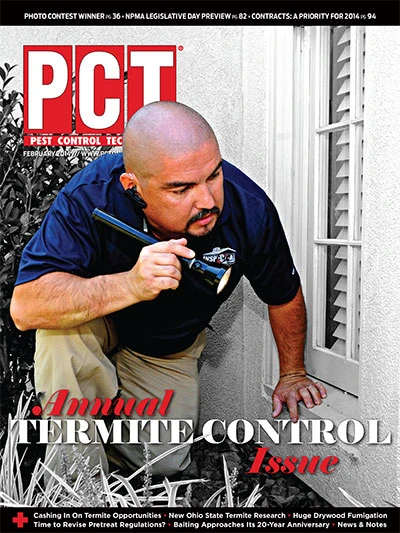 At NPMA Legislative Day 2013, attendees raised awareness about the need for the Pest Elimination Services Transparency & Terminology (PESTT) Act (H.R. 730). The issue stemmed from a 1987 law that authorized USDA-WS to work at non-agricultural settings. Although the primary intent of the legislation was to permit USDA-WS to control birds at airports and engage in rabies control initiatives, the language was written very broadly and authorized almost any type of vertebrate work imaginable, except “urban rodent control.”
At NPMA Legislative Day 2013, attendees raised awareness about the need for the Pest Elimination Services Transparency & Terminology (PESTT) Act (H.R. 730). The issue stemmed from a 1987 law that authorized USDA-WS to work at non-agricultural settings. Although the primary intent of the legislation was to permit USDA-WS to control birds at airports and engage in rabies control initiatives, the language was written very broadly and authorized almost any type of vertebrate work imaginable, except “urban rodent control.”
In the months following Legislative Day, attendees saw the fruits of their labors when NPMA and the USDA-WS reached agreement on the definition of the term “urban rodent control,” which, for the first time, established meaningful parameters as to the work USDA-WS can and cannot perform. That outcome undoubtedly was influenced by Legislative Day visits. Also at last year’s Legislative Day, attendees made their reps aware of what NPMA and others believe is U.S. EPA’s misguided proposed order cancelling the food uses for sulfuryl fluoride. Through the work of NPMA and others, the finalized Farm Bill includes a provision that retains the use of sulfuryl fluoride for food uses. At press time, the bill had just passed the House and was headed to the Senate, which was expected to send it to President Obama’s desk.
|
Beekeeper partnerships Some progressive pest control companies concerned with the pollinator issue have partnered with beekeepers. Columbus, Ohio-based Varment Guard has the good fortune of having three staff members who also are hobbyist beekeepers. “One of the issues we ran into was that, unless the bees were swarming and easily accessible, the beekeepers didn’t want to go to the trouble of taking them out of the walls, or the cavities of trees,” said John Livingston, director of bird operations, Varment Guard. “Then, later in the year, the issue was finding a beekeeper to overwinter them.” Additionally, Livingston said Varment Guard would have to make multiple treatments to honeybee hives in wall cavities and eventually have to kill the hive, adding, “Like most pest control companies, we don’t want to kill honeybees and only do so as a last resort.” One Varment Guard technician/beekeeper, Charlie Reffitt, also recognized challenges working with beekeepers, including his experience working at a golf course that had a honeybee swarm in a tree. A beekeeper was called to remove the swarm, but by the time she arrived (six hours later) the swarm had migrated to a pump house (inside a concrete wall). Unfortunately, the last resort option of a pesticide treatment was necessary. “I thought, ‘Man I could have reacted quicker, gotten to the bees and saved them,” Reffitt recalled. This experience spurred Reffitt to create Varment Guard’s honeybee program. After Reffitt consulted with area beekeepers, the end result was a live removal program that involves: 1) relocating the queen and swarm into a cardboard box for transfer to an empty hive; or 2) funnel-trapping the bees out and capturing them with a decoy hive, a.k.a. “nuc(leus) box,” containing a queen and a few worker bees. If honeybees cannot be extracted live and must be killed in a wall or attic, a Varment Guard technician will apply an appropriately labeled aerosol and/or dust insecticide into the cavity containing the hive. At some point following the treatment the dead bees, comb and honey are removed. Livingston said this service offering has become popular with Varment Guard customers and the company is able to offer it for a nominal service fee. |
“At Legislative Day, we want to say thanks to [attendees] for the Wildlife Services victory and, hopefully, the sulfuryl fluoride outcome,” said Gene Harrington, vice president, government affairs, NPMA. “Secondly, we want our members to use their congressional visits as an opportunity to educate their reps about the pollinator issue. To educate them that certain alleged solutions, such as what the EU has done, are maybe not appropriate or helpful.”
There was, in fact, legislation introduced last year in the House, “Saving America’s Pollinators Act of 2013” (H.R.269), that is similar to the EU moratorium to ban three pesticides (clothianidin, imidacloprid and thiamethoxam). Additionally, in recent months, legislation banning the sale or use of neonicotinoid pesticides or prohibiting certain use patterns has been introduced in Maine, New Jersey, New York, Puerto Rico and Vermont. However, Harrington said the goal for Legislative Day attendees is not necessarily to lobby against such proposed legislation, but rather for attendees to explain the industry’s position on the pollinator issue, and share talking points, including:
- Though beneficial, bees pose health and safety risks to the public. Stinging insects send an estimated 500,000 people to the hospital every year and are the leading cause of anaphylaxis-related deaths in the United States. Consequently, bees are — and some government entities have deemed them — a public safety hazard. Furthermore, some bees are also wood-destroying pests;
- Professional structural pest control applicators are specifically trained to use pesticides consistent with U.S. Environmental Protection Agency approved label directions;
- The industry uses pest control products according to precautions printed on the products’ labels, in order to ensure that the product has the desired benefit without causing bee mortality;
- Many pest management professionals (PMPs) have working relationships with beekeepers, whom they often call when asked to deal with honeybees. Beekeepers are then able to collect the bees alive (see related article, right);
- The decline in bee health is an extremely complicated phenomenon that involves a variety of factors including parasites, disease and loss of bee habitat.
Possible Legislative Movement.
This year’s Legislative Day also is important because of the potential for greater levels of legislative activity in the first few months of 2014. In October, the U.S. government entered a shutdown after Congress failed to enact legislation appropriating funds for fiscal year 2014; however, since the shutdown, Harrington said there has been a “slight increase in the level of cooperation between Democrats and Republicans and an uptick in legislative activity.” It’s possible there could be a flurry of activity this spring, before congressional members go into “campaign mode.”
Speakers and Sessions.
In addition to making congressional visits, Legislative Day attendees will hear from leading speakers including: a debate between political pundits Pat Buchanan (R) and Donna Brazile (D), sponsored by FMC Professional Solutions; John Heilemann, author and MSNBC political analyst, sponsored by Dow AgroSciences; Mike Allen, Chief White House Correspondent, sponsored by Control Solutions Inc.; economist Edwin Nichols, sponsored by Bayer; and the Honorable Rand Paul (R-KY). For more information about NPMA Legislative Day visit http://bit.ly/1jo2weE.
The author is Internet editor of PCT magazine and can be contacted at bharbison@gie.net.

Explore the February 2014 Issue
Check out more from this issue and find your next story to read.
Latest from Pest Control Technology
- Moneypenny is a Provider of Virtual Receptionists
- Video: Top 10 PCT Photo Contest Finalists
- Massey Services Expands with Southeast Commercial Region
- Pest Management Foundation Announces Kevin J. Burns Scholarship
- How to Identify Clover Mites
- Termite Threat Halted in Southern Florida
- PCT Media Group Adds Managing Editor Katie Hobbins
- Evens Clerjuste on Team Communication as Company Growth Point





